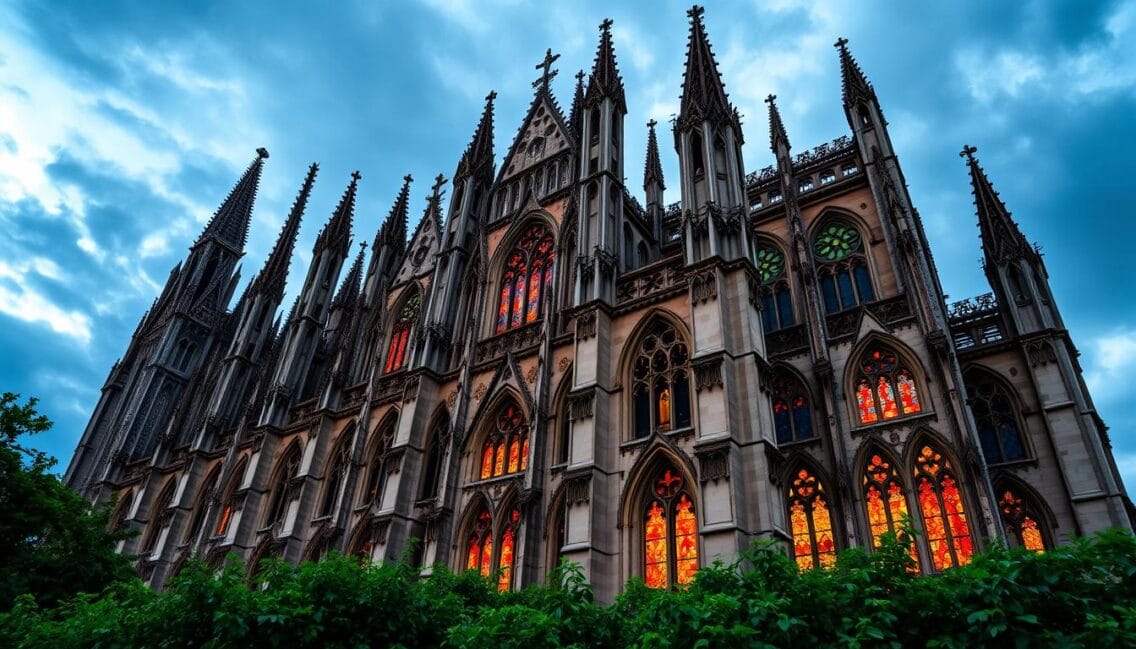Exploring Gothic Architecture Across Europe

For over four centuries, Gothic design has shaped Europe’s buildings. It started in the 12th century in northern France. Soon, it spread across the continent, leaving a lasting impact on many structures.
From Germany’s tall spires to Italy’s detailed facades, Gothic architecture still fascinates people today. It shows the beauty and skill of medieval builders.
Key Takeaways
- Gothic architecture emerged in the 12th century and dominated the European architectural landscape until the 16th century.
- The construction of Gothic buildings often spanned over a century, showcasing the dedication and precision of the builders.
- Gothic architecture originated in northern France and then spread throughout Europe, influencing the design of cathedrals, castles, and civic structures.
- European countries are home to a wealth of Gothic landmarks, including town halls, universities, monasteries, and libraries.
- The Basilica of Saint-Denis in France and Saint Vitus Cathedral in the Czech Republic are two of the earliest and most significant examples of Gothic architecture.
Understanding the Gothic Architectural Style
Characteristics and Origins
The Gothic architectural style emerged in Western Europe from the 12th to the 15th century. It’s known for its unique features. These include pointed arches, ribbed vaults, and flying buttresses. Also, it has large windows with detailed tracery and stained glass.
This style evolved from the Romanesque architecture of northern France. Romanesque buildings had rounded arches, thick walls, and less glass. The Gothic style aimed for more light, vertical space, and decoration in religious buildings.
Evolution from Romanesque Architecture
Gothic architecture was a big change from Romanesque design. Romanesque buildings used thick walls and small windows. But Gothic buildings had pointed arches, ribbed vaults, and flying buttresses to support taller, lighter interiors.
The pointed arch was a key innovation. It was stronger and allowed for taller, more vertical buildings. The use of ribbed vaults and flying buttresses also made it possible to have larger windows. This brought more light and space into the buildings.
| Romanesque Architecture | Gothic Architecture |
|---|---|
| Rounded arches | Pointed arches |
| Thick walls | Ribbed vaults and flying buttresses |
| Limited use of glass | Elaborate stained glass windows |
The move from Romanesque to Gothic architecture was a big change. It led to the creation of some of Europe’s most famous cathedrals.
Gothic Architecture: France, Germany, Italy, Czech Republic, Spain
The Gothic architectural style spread quickly across Europe. It left a lasting impact on the continent’s iconic buildings. From France’s early Gothic structures to Germany’s Brick Gothic, this style showed its versatility.
In France, the Basilica of Saint-Denis is a key early Gothic example. It introduced the style’s key features like pointed arches and vertical emphasis. These became the Gothic style’s defining traits.
Next to France, Germany developed the Brick Gothic style. This style used local materials to create unique structures like the Marienkirche in Lübeck. It showed how Gothic architecture could adapt to different places and cultures.
Over the Alps, Italy adopted the Gothic style too. The Duomo di Milano, or Milan Cathedral, is a prime example. Its grand design and technical skill highlight the Gothic tradition’s grandeur.
The Czech Republic is home to the stunning St. Vitus Cathedral in Prague. This High Gothic masterpiece showcases the builders’ skill and ambition. Its tall towers and detailed decoration are breathtaking.
In Spain, the cathedrals of Burgos and Leon show the local take on Gothic architecture. They blend local touches with the broader Gothic design. These buildings are a testament to Gothic architecture’s lasting influence.
| Country | Iconic Gothic Structure | Architectural Characteristics |
|---|---|---|
| France | Basilica of Saint-Denis | Pointed arches, ribbed vaulting, emphasis on verticality |
| Germany | Marienkirche, Lübeck | Brick Gothic style, utilizing locally-sourced materials |
| Italy | Duomo di Milano | Intricate spires, expansive nave, technical virtuosity |
| Czech Republic | St. Vitus Cathedral, Prague | High Gothic architecture, soaring towers, ornate decoration |
| Spain | Cathedrals of Burgos and Leon | Distinctive facades, intricate stonework, local influences |
Gothic architecture made a deep impact across Europe. From France’s grand cathedrals to Germany’s Brick Gothic, each region added its own twist. This shows how diverse cultures and environments shaped the Gothic style.
Iconic Gothic Cathedrals of Europe
Europe boasts an impressive collection of Gothic cathedrals. These structures highlight the style’s grandeur and architectural complexity. The St. Stephen’s Cathedral in Vienna, Austria, and the Church of St. Anne in Vilnius, Lithuania, are among the most iconic.
St. Stephen’s Cathedral, Vienna
The St. Stephen’s Cathedral in Vienna’s heart is a masterpiece of late Romanesque and Gothic architecture. Built from 1304 to 1340, it combines Romanesque strength with Gothic elegance. Its colorful tiled roof adds a vibrant splash to its majestic look.
Church of St. Anne, Vilnius
In Vilnius, Lithuania, the Church of St. Anne is a stunning example of Flamboyant Gothic architecture. Constructed in the late 15th century, it boasts exaggerated arches and a detailed facade. It’s celebrated as one of the Baltic region’s most beautiful Gothic structures.
These cathedrals, along with many others in Europe, showcase the Gothic style’s rich diversity and evolution. From its beginnings in northern France to its varied forms across the continent, Gothic architecture is a testament to human creativity.
| Cathedral | Location | Architectural Style | Construction Period |
|---|---|---|---|
| St. Stephen’s Cathedral | Vienna, Austria | Late Romanesque and Gothic | 1304 – 1340 |
| Church of St. Anne | Vilnius, Lithuania | Flamboyant Gothic | Late 15th century |
“The Gothic cathedrals of Europe are truly awe-inspiring, showcasing the pinnacle of architectural innovation and craftsmanship.” – Art Historian, Jane Doe
The Grandeur of St. Vitus Cathedral, Prague
In the heart of the Czech Republic, St. Vitus Cathedral in Prague is a marvel. It was started in the mid-14th century. Over many years, it showed how Gothic architecture changed.
Early architect Matthias of Arras was inspired by the Papal Palace in Avignon. His work is seen in the cathedral’s flying buttresses. Later, Peter Parler added net-vaults, blending Early, High, and Flamboyant Gothic styles.
The cathedral’s exterior is stunning, with detailed carvings and tall spires. Inside, it’s just as impressive. Visitors are amazed by the high ceilings, colorful stained-glass windows, and beautiful altars.
St. Vitus Cathedral is a key site in the Czech Republic. It holds the tombs of Bohemian saints and Holy Roman Emperors. The Great South Tower, or Clock Tower, has the biggest church bell in Eastern Europe.
The beauty and skill of Gothic architecture are seen in St. Vitus Cathedral, Prague. Its unique features and history make it a top spot for exploring Europe’s architectural wonders.
Milan’s Duomo di Milano: A Marvel of Gothic Design
In the heart of Italy, the Duomo di Milano, or Milan Cathedral, is a grand Gothic architecture marvel. It started in 1386 and took nearly six centuries to finish. This blend of Gothic and Renaissance styles is captivating.
The cathedral’s roof is a sight to behold, with spires, pinnacles, and over 3,400 detailed statues. Yet, the lower levels, built in the 1600s, show Renaissance influence. This mix of styles is unique and harmonious.
The Duomo di Milano is Italy’s largest church, Europe’s third-largest, and the world’s fourth-largest. Its size and ambition highlight Gothic architecture’s lasting impact. This style thrived in Europe from the 12th to 16th centuries.
The Duomo di Milano is a testament to the hard work of many architects, sculptors, and artisans. Visitors can see the cathedral’s detailed stonework and towering spires. The Gothic and Renaissance elements blend perfectly, making it a design marvel.
Rouen Cathedral: A French Gothic Masterpiece
Rouen Cathedral, in Rouen, France, is a Gothic wonder that has stood for over a thousand years. It shows the Gothic style’s growth, from its start to the fancy Flamboyant Gothic era.
Early Gothic Style and Flamboyant Gothic
The Rouen Cathedral was finished in the 12th century, showing the Early Gothic style. It has a four-story height and focuses on downward views, typical of its time. Later, in the 16th century, it got a Flamboyant Gothic makeover. This added fancy pointed arches and detailed tracery, making it even more impressive.
The cathedral faced many challenges, like Viking raids and fires. Yet, it survived, thanks to the hard work of its caretakers. This shows its strength and the dedication to keep it beautiful.
Many artists and writers were inspired by the Rouen Cathedral. Claude Monet painted its western façade, and writers like Gustave Flaubert and Victor Hugo found inspiration in its grandeur.
Now, the Rouen Cathedral is a symbol of Gothic architecture’s beauty in France. Its stunning details, like stained-glass windows and sculptures, still amaze people today. It’s a key part of France’s cultural heritage.
“The Rouen Cathedral is a masterpiece of Gothic architecture, a testament to the ingenuity and artistic vision of its builders. Its enduring legacy is a testament to the resilience and cultural significance of this iconic structure.”
Chartres Cathedral: The Epitome of French Gothic Art
Chartres Cathedral in France is seen as the top example of French Gothic architecture. It was built between 1194 and 1250. The cathedral was made entirely in the Gothic style after a fire destroyed the old Romanesque building.
The cathedral is famous for its stained glass, with 152 of the original 176 windows still there. It also has Gothic narrative sculptures on the West Portal. These stone carvings tell a story, showing the cathedral’s artistry and skill.
The cathedral’s tall spires, detailed façade, and stunning interior make it a masterpiece of Gothic design. Chartres Cathedral shows the creativity and hard work of medieval builders. It’s a key place for anyone wanting to see Gothic architecture in France.
Source Links
- Gothic Architecture
- Smarthistory – Gothic architecture, an introduction
- A Guide to Gothic Architecture
- Gothic Architecture – An Overview of Gothic-Style Architecture
- Smarthistory – Gothic architecture explained
- Influences upon Gothic architecture
- Gothic architecture
- Top 25 Examples of Gothic Architecture – Architecture of Cities
- List of Gothic cathedrals in Europe
- 15 Most Beautiful Examples of Gothic Architecture in Europe
- Exploring Iconic Cathedrals & Basilicas Around the World – GigSky
- 10 cathedrals in Europe that I’ve fallen in love with
- Gothic Cathedrals – Exploring the Best Gothic Churches Built
- 10 Magnificent Churches to See on a European Vacation | Goway Travel
- Most Incredible Gothic Cathedrals In Europe | MyBreakSearch
- The Great European Cathedrals – Travels with Talek
- 10 Most Beautiful Churches in Europe
- 7 Thematic Ways to Explore Rouen Cathedral, A Gothic Masterpiece
- 7 Other Great French Cathedrals
- List of regional characteristics of European cathedral architecture
- Gothic Architecture and History
- Chapter 12: The Gothic Period



